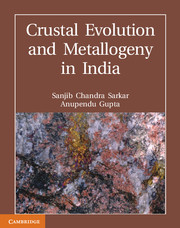Book contents
- Frontmatter
- Dedication
- Contents
- List of Figures
- List of Tables
- List of Plates
- Preface
- Chapter 1 Southern India
- Chapter 2 Central India
- Chapter 3 Eastern Ghat Belt
- Chapter 4 Eastern India
- Chapter 5 North-East India
- Chapter 6 Western India
- Chapter 7 The Himalaya
- Chapter 8 Crustal Evolution and Metallogeny in India: A Brief Review in the Context of the World Scenario
- References
- Index
- Plate Section
Chapter 6 - Western India
Published online by Cambridge University Press: 05 February 2014
- Frontmatter
- Dedication
- Contents
- List of Figures
- List of Tables
- List of Plates
- Preface
- Chapter 1 Southern India
- Chapter 2 Central India
- Chapter 3 Eastern Ghat Belt
- Chapter 4 Eastern India
- Chapter 5 North-East India
- Chapter 6 Western India
- Chapter 7 The Himalaya
- Chapter 8 Crustal Evolution and Metallogeny in India: A Brief Review in the Context of the World Scenario
- References
- Index
- Plate Section
Summary
Geology and Crustal Evolution
Introduction
‘Western India’ in the present context, encompasses a region now mostly covered by the states of Gujarat, Rajasthan, Haryana and Delhi (Fig. 6.1.1). Geologically the region includes the Aravalli–Delhi orogenic belt and the lithostratigraphic units adjacent thereto.
Investigations into the geology of parts of this region started in the nineteenth century itself (Hacket, 1881). With the beginning of the twentieth century, the Geological Survey of India undertook an elaborate programme of geological investigation in some regions of the country, which included Rajasthan and its adjacent areas. Some outstanding results of these investigations are contained in the publications of Heron (1917 a, b; 1936 and 1953), Gupta (1934), Gupta and Mukherjee (1938). Modern concepts of structure–tectonics, petrology and geochronology hardly, if at all, had developed by that time. The earlier concepts radically changed since about the middle of the last century. As a fallout now, we have also collected a fair amount of new data related to those aspects, and new interpretations of the geology of the region based thereon have been offered. However, as we will see later in this section, some of the basic tenets of early work remain more or less valid. This particularly refers to the regional geological maps prepared and regional stratigraphy suggested.
- Type
- Chapter
- Information
- Crustal Evolution and Metallogeny in India , pp. 543 - 678Publisher: Cambridge University PressPrint publication year: 2012
- 2
- Cited by



